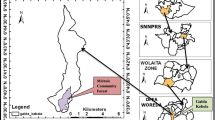Abstract
Niubeiliang National Nature Reserve (NNR, 108°45′–109°04′E, 33°47′–33°56′N) is located on the eastern range of the Qinling Mountains in Shaanxi Province, China and spans the southern and northern slopes of Mt. Qinling. A transect survey and investigation were carried out in NNR to determine the fauna characteristics and ecological distribution of carnivora and artiodactyla from May 2003 to August 2004. The NNR has 18 mammals (carnivore and artiodactyl), two of which belong to the first class and seven to the second class of state key protected wildlife in China. The results of this study indicated that ungulates were abundant in the NNR, as all ungulates that were distributed within Mt. Qinling could be found within the reserve. However, only 45.5% of the carnivores distributed within Mt. Qinling were detected within the NNR. Among the mammals, there were 12 oriental species (66.7%), 1 palearctic specie (5.5%) and 5 widely-distributed species (27.8%). The NNR is a crossing area of palearctic species and oriental species on the zoogeographical regions, and it is a transitional area from the oriental realm to the palearctic realm. The results of the analysis on the ecological distribution of carnivore and artiodactyl in the area showed that their elevation ranges had large differences. The species whose elevation ranges above 1 300 m, about 1 000 m, and in 450–700 m occupied one third respectively. The results also indicated that species richness for the memals in the NNR peaked at a middle elevation (rising at first, then descending with the increase in elevation). Not only on the southern slope, but also on the northern slope of Mt. Qinling, the number of species distributed in the area at 1 800–2 200 m a.s.l. was the largest (more than 80%), while the number of species distributed in the area above 2 600 m a.s.l. was the smallest (about 50%). Elevation gradients of species richness for the mammals in the NNR also embodied the mammal distributions among the vegetation types. The number of species distributed in the mixed coniferous and broadleaf deciduous forest at middle elevations was the largest, while the number of species distributed in the broadleaf deciduous forest at middle and low elevations, subalpine coniferous forest, subalpine shrubbery and meadow was relatively smaller.
Similar content being viewed by others
References
Brown J H (2001). Mammals on mountainsides: elevational pattern of diversity. Global Ecology and Biogeography, 10: 101–109
Chen F G, Min Z L, Huang H F, Ma Q H, Luo Z T (1980). A study of mammalian fauna of Qinlin-Daba mountains, Shaanxi. Journal Northwest University (Natural Science Edition), 1: 137–147 (in Chinese)
Chen L Z (1993). Biodiversity in China: Status and Its Protection Strategy. Beijing: Science Press (in Chinese)
Chen S H (2003). Animal resource and its faunal characteristics of Caiyanghe Nature Reserve. Forest Inventory and Planning, 28(1): 32–36 (in Chinese)
Heaney L R (2001). Small mammal diversity along elevational gradients in the Philippines: an assessment of patterns and hypotheses. Global Ecology and Biogeography, 10: 15–39
Li B G, He P J, Wang J T, Guo B, Wei W K, Hu Y L, Si K C, Liu Y P (1997). An analysis of the fauna of mammals in Zhouzhi National Nature Reserve on the northern slope of the Qinling Mountains. Journal Northwest University (Natural Science Edition), 27(3): 235–238 (in Chinese)
Liu S F, Zhang J (2003). Research and Protection on Biodiversity in Foping Nature Researve. Xi’an: Shanxi Science and Technology Press (in Chinese)
Lomolino M V (2001). Elevation gradients of species-density: historical and prospective views. Global Ecology and Biogeography, 10: 3–13
Md Nor S (2001). Elevational diversity patterns of small mammals on Mount Kinabalu, Sabah, Malaysia. Global Ecology and Biogeography, 10: 41–62
Min Z L (1991). Key Protected Wildlife in Shaanxi Province. Beijing: China Forestry Publishing House (in Chinese)
Rickart E A (2001). Elevational diversity gradients, biogeography and the structure of montane mammal communities in the intermountain region of North America. Global Ecology and Biogeography, 10, 77–100.
Ruan S J, Gong H S (1999). Mammal resources in Niubeiliang National Nature Reserve, Shanxi Province. Chinese Journal Zoology, 34(2): 30–35 (in Chinese)
Wang Y X (2002). A Complete Checklist of Mammal Species and Subspecies in China: A Taxonomic and Geographic Reference. Beijing: China Forestry Publishing House (in Chinese)
Wu J Y (1986). Giant panda in the Qinling Mountains. Acta Zoologica Sinica, 32(1): 92–95 (in Chinese)
Wu J Y, Han Y P, Yong Y G, Zhao J W (1986). Mammals of the conservation reserve in Foping. Chinese Wildlife, 3: 1–4 (in Chinese)
Wu J Y, Li G H (1982). A report on the mammals of Ankang region of Shaanxi province. Zoological Research, 3(1): 59–68 (in Chinese)
Yang M S, Li G C, Chen D S, Li C P (1994). Forest Classify and Regeneration of Active Cutting in Qinling. Xi’an: Shanxi Science and Technology Press (in Chinese)
Zhang R Z (1999). Zoogeography of China. Beijing: Science Press (in Chinese)
Zheng Y L (1982). Mammalian fauna of the eastern part of Qinling Mountains, Shanxi province, China. Chinese Journal Zoology, 2: 15–19 (in Chinese)
Zheng Y L, Yao J C, Jiang Y A (1982). Abundance and distribution of protected animals in Shanxi province. Chinese Wildlife, (3): 26–28 (in Chinese)
Zhang Z J (2001). Study on the fauna of Manmmals in Songpan district. Journal of Sichuan Teachers College (Natural Science), 22(2): 120–126 (in Chinese)
Author information
Authors and Affiliations
Corresponding author
Additional information
Translated from Acta Ecologica Sinica, 2005, 25(9): 2249–2255 [译自: 生态学报]
Rights and permissions
About this article
Cite this article
Zeng, Z., Song, Y., Ma, Y. et al. Fauna characteristics and ecological distribution of Carnivora and Artiodactyla in Niubeiliang National Nature Reserve, China. Front. Biol. China 2, 92–99 (2007). https://doi.org/10.1007/s11515-007-0016-4
Issue Date:
DOI: https://doi.org/10.1007/s11515-007-0016-4




